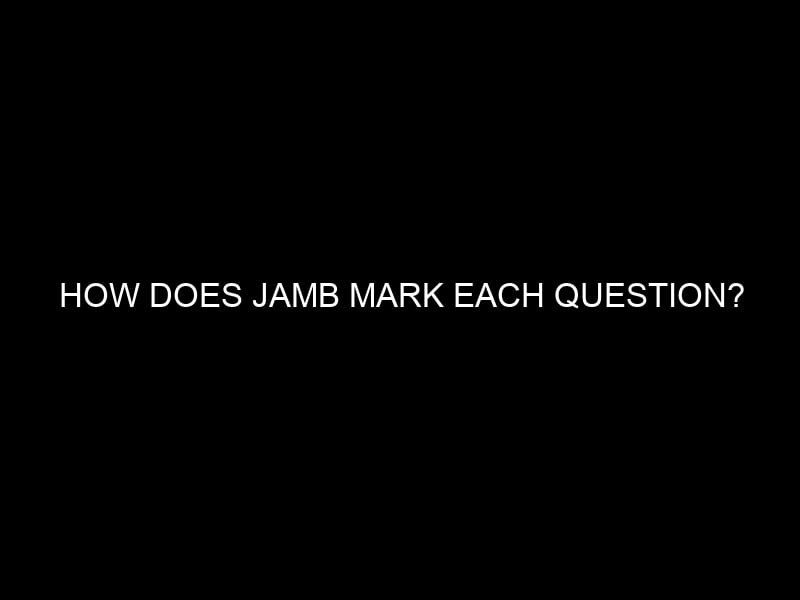The Joint Admissions and Matriculation Board (JAMB) is the organization responsible for conducting the Unified Tertiary Matriculation Examination (UTME) in Nigeria. The exam is a requirement for admission into tertiary institutions in Nigeria, and the scores obtained in the exam are used as a criterion for admission. One question that often comes up among students is how JAMB marks each question. In this essay, we will discuss this topic in detail.
The JAMB Exam Format: Before discussing how JAMB marks each question, it is essential to understand the format of the JAMB exam. The JAMB exam consists of four subjects: English Language, Mathematics, and two other subjects relevant to the candidate’s course of study. The exam is computer-based and consists of 180 multiple-choice questions, with 60 questions in each subject. Each question has four options, and candidates are required to choose the correct answer.
How JAMB Marks Each Question: JAMB uses a computerized system to mark the UTME. The system is designed to automatically mark each question and compute the candidate’s score. The marking scheme used by JAMB is called the “item response theory” (IRT).
The IRT is a statistical model used to measure the ability of a candidate based on their responses to test questions. The IRT model used by JAMB is called the “one-parameter logistic model” (1PLM). The 1PLM model assumes that the probability of a candidate answering a question correctly depends on the difficulty of the question and the candidate’s ability.
The IRT model used by JAMB is designed to ensure that the exam is fair and reliable. The model is based on the assumption that questions of varying difficulty levels are included in the exam. The model also assumes that candidates of varying abilities take the exam.
The marking scheme used by JAMB is based on the number of correct answers given by the candidate. Each correct answer attracts one mark, and each incorrect answer attracts negative marking. The negative marking is designed to discourage candidates from guessing the answers.
The marking scheme used by JAMB is as follows:
- Correct Answer: Each correct answer attracts one mark.
- Incorrect Answer: Each incorrect answer attracts negative marking. The negative marking is designed to discourage candidates from guessing the answers. The amount of negative marking varies, depending on the subject. For example, in the English Language, each incorrect answer attracts a penalty of 0.25 marks, while in Mathematics, each incorrect answer attracts a penalty of 0.33 marks.
- Unanswered Question: Unanswered questions do not attract any marks. Candidates are advised to attempt all the questions in the exam.
The total score obtained by a candidate in the JAMB exam is the sum of the marks obtained in each subject. The maximum score that can be obtained in the JAMB exam is 400, with 100 marks in each subject.
How JAMB Ensures Fairness and Reliability:
JAMB uses several measures to ensure that the UTME is fair and reliable. These measures include:
- Randomization: The questions in the UTME are randomized to ensure that no two candidates get the same set of questions. This ensures that the exam is fair and that no candidate has an unfair advantage.
- Item Analysis: JAMB conducts an item analysis after each exam to determine the difficulty level of each question. This analysis helps JAMB to determine the validity and reliability of the exam.
- Cut-off Marks: JAMB sets cut-off marks for each subject and for each institution. The cut-off marks are based on the performance of the candidates and the admission requirements of the institutions.
- Standardization: JAMB uses standardization to ensure that the scores obtained by the candidates are comparable across different exam sessions. This is done by scaling the scores based on the difficulty level of the questions.
- Monitoring: JAMB monitors the exam process to ensure that it is conducted in a fair and transparent manner. The exam is conducted under strict supervision, and any form of malpractice is dealt with severely.
Conclusion
In conclusion, JAMB uses a computerized system to mark the UTME. The system is designed to automatically mark each question and compute the candidate’s score. The marking scheme used by JAMB is based on the number of correct answers given by the candidate, with negative marking for incorrect answers. JAMB uses several measures to ensure that the UTME is fair and reliable, including randomization of questions, item analysis, cut-off marks, standardization, and monitoring. It is essential for candidates to understand the marking scheme used by JAMB to prepare adequately for the exam and increase their chances of success.

